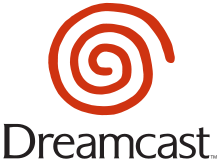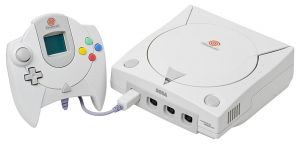Difference between revisions of "Configuration:Sega Dreamcast"
| (3 intermediate revisions by the same user not shown) | |||
| Line 1: | Line 1: | ||
| + | {{Infobox System|Logo=logo-sega-dreamcast.png|Image=device-dreamcast.jpg|Year=1998|Manufacturer=Sega|Type=Video game console|CPU=Hitachi SH-4 32-bit RISC @ 200 MHz|GPU=100 MHz PowerVR2, integrated with the system's ASIC|Sound CPU=ARM7 RISC|Sound Chip=67 MHz Yamaha AICA with 32-bit ARM7 RISC CPU core, 64 channels|Memory=16 MB RAM, 8 MB video RAM, 2 MB audio RAM|Controllers=Analog<br>Keyboard<br>Arcade<br>Wheel<br>Marracas<br>Fishing<br>DreamEye<br>Enforcer}} | ||
| + | |||
== Platform Information == | == Platform Information == | ||
| + | ''from Wikipedia'' | ||
| + | |||
| + | The Dreamcast is a home video game console released by Sega on November 27, 1998 in Japan, September 9, 1999 in North America, and October 14, 1999 in Europe. It was the first in the sixth generation of video game consoles, preceding Sony's PlayStation 2, Nintendo's GameCube and Microsoft's Xbox. The Dreamcast was Sega's final home console, marking the end of the company's 18 years in the console market. | ||
| + | |||
| + | In contrast to the expensive hardware of the unsuccessful Sega Saturn, the Dreamcast was designed to reduce costs with "off-the-shelf" components, including a Hitachi SH-4 CPU and an NEC PowerVR2 GPU. Released in Japan to a subdued reception, the Dreamcast enjoyed a successful U.S. launch backed by a large marketing campaign, but interest in the system steadily declined as Sony built hype for the upcoming PlayStation 2. Sales did not meet Sega's expectations despite several price cuts, and the company continued to incur significant financial losses. After a change in leadership, Sega discontinued the Dreamcast on March 31, 2001, withdrawing from the console business and restructuring itself as a third-party publisher. 9.13 million Dreamcast units were sold worldwide. | ||
| + | |||
| + | Although the Dreamcast had a short lifespan and limited third-party support, reviewers have considered the console ahead of its time. Its library contains many games considered creative and innovative, including Crazy Taxi, Jet Set Radio and Shenmue, as well as high-quality ports from Sega's NAOMI arcade system board. The Dreamcast was also the first console to include a built-in modem for Internet support and online play. | ||
=== Media Devices === | === Media Devices === | ||
| Line 9: | Line 18: | ||
Below is a list of available emulators for this platform. | Below is a list of available emulators for this platform. | ||
| + | * [[Emulator:flycast|flycast]] | ||
* [[Emulator:reicast|reicast]] | * [[Emulator:reicast|reicast]] | ||
* [[Emulator:lxdream|lxdream]] | * [[Emulator:lxdream|lxdream]] | ||
* [[Emulator:Demul|Demul (Wine)]] | * [[Emulator:Demul|Demul (Wine)]] | ||
| + | |||
| + | == External Links == | ||
| + | * [https://en.wikipedia.org/wiki/Dreamcast Wikipedia] | ||
| + | * [https://segaretro.org/ Sega Retro] | ||
| + | |||
[[Category:Platform]] | [[Category:Platform]] | ||
Latest revision as of 02:04, 14 July 2022
| Sega Dreamcast | ||
|---|---|---|

| ||

| ||
| Manufacturer | Sega | |
| Type | Video game console | |
| CPU | Hitachi SH-4 32-bit RISC @ 200 MHz | |
| GPU | 100 MHz PowerVR2, integrated with the system's ASIC | |
| Sound CPU | ARM7 RISC | |
| Sound Chip | 67 MHz Yamaha AICA with 32-bit ARM7 RISC CPU core, 64 channels | |
| Memory | 16 MB RAM, 8 MB video RAM, 2 MB audio RAM | |
| Controllers | Analog Keyboard Arcade Wheel Marracas Fishing DreamEye Enforcer | |
| Year | 1998 | |
Platform Information
from Wikipedia
The Dreamcast is a home video game console released by Sega on November 27, 1998 in Japan, September 9, 1999 in North America, and October 14, 1999 in Europe. It was the first in the sixth generation of video game consoles, preceding Sony's PlayStation 2, Nintendo's GameCube and Microsoft's Xbox. The Dreamcast was Sega's final home console, marking the end of the company's 18 years in the console market.
In contrast to the expensive hardware of the unsuccessful Sega Saturn, the Dreamcast was designed to reduce costs with "off-the-shelf" components, including a Hitachi SH-4 CPU and an NEC PowerVR2 GPU. Released in Japan to a subdued reception, the Dreamcast enjoyed a successful U.S. launch backed by a large marketing campaign, but interest in the system steadily declined as Sony built hype for the upcoming PlayStation 2. Sales did not meet Sega's expectations despite several price cuts, and the company continued to incur significant financial losses. After a change in leadership, Sega discontinued the Dreamcast on March 31, 2001, withdrawing from the console business and restructuring itself as a third-party publisher. 9.13 million Dreamcast units were sold worldwide.
Although the Dreamcast had a short lifespan and limited third-party support, reviewers have considered the console ahead of its time. Its library contains many games considered creative and innovative, including Crazy Taxi, Jet Set Radio and Shenmue, as well as high-quality ports from Sega's NAOMI arcade system board. The Dreamcast was also the first console to include a built-in modem for Internet support and online play.
Media Devices
- GD-ROM Discs
- Original media is not readable on PC
- Disc Images
Available Emulators
Below is a list of available emulators for this platform.